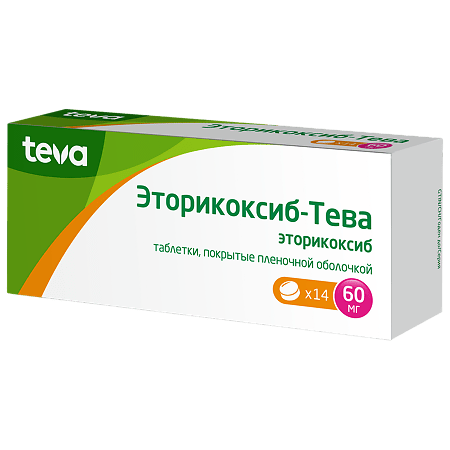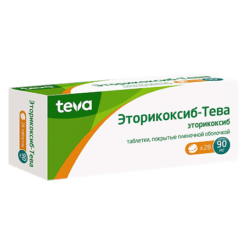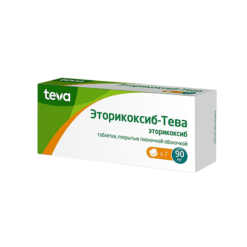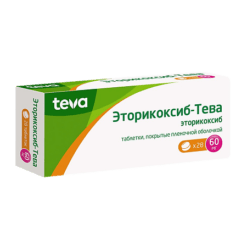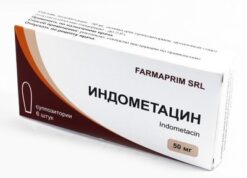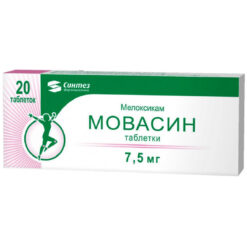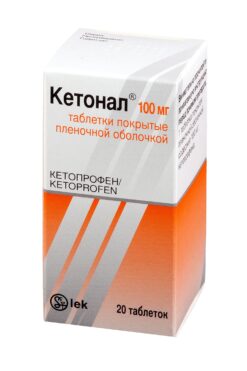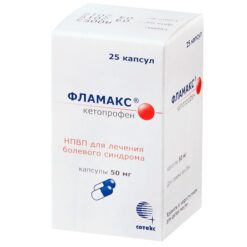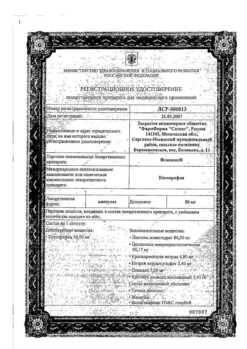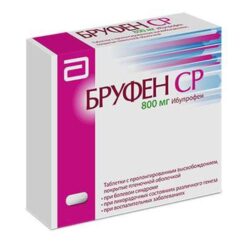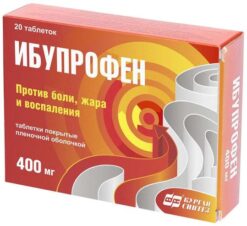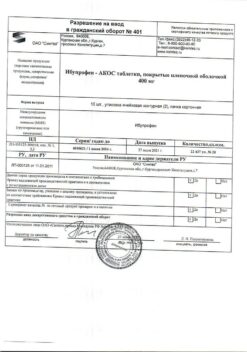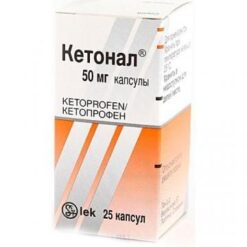No products in the cart.
Etoricoxib-Teva, 60 mg 14 pcs
€13.47 €11.79
Description
Pharmacotherapeutic group: Non-steroidal anti-inflammatory drugs (NSAIDs).
ATX code: M01AN05
Pharmacological properties
Pharmacodynamics
Etoricoxib is a selective cyclooxygenase-2 (COX-2) inhibitor when administered orally in therapeutic concentrations. In clinical pharmacological studies, etoricoxib inhibited COX-2 in a dose-dependent manner, with no effect on COX-1 at a daily dose up to 150 mg. The drug does not inhibit the synthesis of prostaglandins in the gastric mucosa and does not affect platelet function.
Cyclooxygenase is responsible for the formation of prostaglandins. Two isoforms of cyclooxygenase, COX-1 and COX-2, have been isolated. COX-2 is an isoenzyme that is induced by various anti-inflammatory mediators and is considered the main enzyme responsible for the synthesis of prostanoid mediators of pain, inflammation and fever. COX-2 is involved in the processes of ovulation, implantation and closure of the arterial duct, regulation of kidney function and the central nervous system (induction of fever, sensation of pain, cognitive function), and may also play a role in the process of ulcer healing. COX-2 has been found in tissues surrounding gastric ulcers in humans, but its importance in ulcer healing has not been established.
Effectiveness
In patients with osteoarthritis (OA), etoricoxib, when administered at a dose of 60 mg once daily, provided a significant reduction in pain and improvement in patients’ assessment of their condition. These favorable effects were observed on the second day of treatment and persisted for 52 weeks. Studies of etoricoxib at a dose of 30 mg once daily (using similar evaluation methods) demonstrated efficacy compared to placebo over a treatment period of 12 weeks. In a study conducted to determine the optimal dose, etoricoxib, when used at a dose of 60 mg, demonstrated significantly greater improvement than the 30 mg dose for all three primary endpoints after 6 weeks of treatment. The 30 mg dose has not been studied in hand osteoarthritis.
In patients with rheumatoid arthritis (RA), etoricoxib at a dose of 90 mg once daily provided a significant reduction in pain and inflammation and improved mobility. These favorable effects persisted for a treatment period of 12 weeks.
In patients with acute gouty arthritis, etoricoxib, administered at a dose of 120 mg once daily for an eight-day treatment period, reduced moderate to severe joint pain and inflammation. The efficacy was comparable to that of indomethacin when used in a dose of 50 mg three times a day. Pain reduction was noted as early as four hours after the start of treatment.
In patients with ankylosing spondylitis, etoricoxib at a dose of 90 mg once daily provided a significant reduction in back pain, inflammation, stiffness, and improved function. The clinical efficacy of etoricoxib was observed on the second day of treatment and was sustained for the entire treatment period of 52 weeks.
In a clinical study of pain after dental surgery, etoricoxib at a dose of 90 mg was administered once daily for three days. In a subgroup of patients with moderate pain (at baseline assessment), etoricoxib had the same analgesic effect as ibuprofen at a dose of 600 mg (16.11 vs. 16.39 P=0.722), and was superior to the paracetamol/codeine combination at a dose of 600 mg/60 mg (11.00, P< 0.001) and placebo (6.84, P< 0.001) according to the overall assessment of pain reduction during the first 6 hours (TOPAR6). The proportion of patients who required rapid-acting pain medication within the first 24 hours of taking the study drugs was 40.8% with etoricoxib at 90 mg, 25.5% with ibuprofen at 600 mg every 6 hours, and 46.7% with the paracetamol/codein combination at 600 mg/60 mg every 6 hours, compared with 76.2% in the placebo group. In this study, the median onset of action (measurable pain reduction) with etoricoxib at a dose of 90 mg was 28 minutes after administration.
Safety
The MEDAL Program(Multinational Assessment Program for Long-Term Prescribing Etoricoxib and Diclofenac in Arthritis
The MEDAL program was a program to evaluate the long-term prescribing of The MEDAL program was a prospective safety assessment program based on cardiovascular (CV) events from pooled data from three randomized, double-blind, active-controlled trials: MEDAL, EDGE II and EDGE.
The MEDAL study was a trial, the duration of which was determined by reaching endpoints (CC events), that included 17,804 patients with OA and 5,700 patients with RA who received etoricoxib at a dose of 60 mg (OA) or 90 mg (OA and PA) or diclofenac at a dose of 150 mg daily for an average of 20.3 months (maximum 42.3 months, median 21.3 months). Only serious adverse events and dropouts due to any adverse events were reported in this study.
The EDGE and EDGE II studies compared the gastrointestinal tolerability of etoricoxib and diclofenac. The EDGE study included 7111 patients with OA who received etoricoxib at a dose of 90 mg per day (1.5 times the recommended dose for OA) or diclofenac at a dose of 150 mg per day for an average of 9.1 months (maximum 16.6 months, median 11.4 months). The EDGE II study included 4,086 patients with RA who received etoricoxib at a dose of 90 mg daily or diclofenac at a dose of 150 mg daily for an average of 19.2 months (maximum 33.1 months, median 24 months).
In the combined MEDAL Program, 34,701 patients with OA or RA were treated for an average of 17.9 months (maximum 42.3 months, median 16.3 months); about 1,800 patients were treated for more than 24 months. Patients included in the MEDAL Program had a wide range of CV and gastrointestinal risk factors at baseline assessment. Patients with recent myocardial infarction and with aortocoronary bypass or percutaneous coronary intervention within 6 months before study inclusion were excluded. Gastroprotectants and low-dose aspirin were allowed in the studies.
General safety
There were no significant differences between etoricoxib and diclofenac regarding the incidence of thrombotic CC events. Cardiorenal adverse events were more frequent with etoricoxib than with diclofenac; this effect was dose-dependent (separate results are presented below). Gastrointestinal (GI) and hepatic adverse events were significantly more frequent with diclofenac than with etoricoxib. The frequency of adverse events in the EDGE and EDGE II studies, as well as adverse events that were considered serious or required treatment withdrawal in the MEDAL study, were higher with etoricoxib than with diclofenac.
Cardiovascular Safety Assessment Results
The frequency of confirmed serious thrombotic CC adverse events (which included cardiac, cerebrovascular, and peripheral vascular events) was comparable between the groups receiving etoricoxib or diclofenac (data are shown in the table below). There were no statistically significant differences in the incidence of thrombotic events between etoricoxib and diclofenac in all subgroups analyzed, including patient categories in the baseline CC risk range. The relative risk for confirmed serious thrombotic CC adverse events was similar for etoricoxib (when administered at 60 mg or 90 mg) and diclofenac (when administered at 150 mg).
Cardiorenal events
Approximately 50% of patients included in the MEDAL study had a history of arterial hypertension at baseline assessment. The dropout rate due to adverse events associated with arterial hypertension was statistically significantly higher for etoricoxib than for diclofenac. The frequency of adverse events related to chronic heart failure (drop-outs and serious events) was similar for etoricoxib in 60 mg dose and diclofenac in 150 mg dose, but was higher for etoricoxib in 90 mg dose compared to diclofenac in 150 mg dose (and statistically significantly higher for etoricoxib in 90 mg dose compared to diclofenac in 150 mg dose in the MEDAL OA group). The frequency of confirmed adverse events related to chronic heart failure (events that were serious and resulted in hospitalization or emergency department visits) was slightly higher for etoricoxib compared to diclofenac in the 150 mg dose; this effect was dose-dependent. Study dropout rates due to edema-related adverse events were higher for etoricoxib compared with diclofenac at a dose of 150 mg; this effect was dose-dependent (statistically significant for etoricoxib at a dose of 90 mg, but not for etoricoxib at a dose of 60 mg).
Results of cardiorenal safety assessment in the EDGE and EDGE studies .II consistent with results in the MEDAL study
. In individual MEDAL Program studies, the absolute dropout rate in any treatment group for etoricoxib (60 mg or 90 mg) was up to 2.6% for arterial hypertension, up to 1.9% for edema, and up to 1.1% for chronic heart failure. Patients taking etoricoxib at a dose of 90 mg had a higher dropout rate than patients taking etoricoxib at a dose of 60 mg.
Results of gastrointestinal tolerability assessments in the MEDAL Program
. In each of the three MEDAL studies, the dropout rate for any clinical GI adverse event (e.g., dyspepsia, abdominal pain, ulcers) was significantly lower for etoricoxib compared with diclofenac. The dropout rate due to GI adverse clinical events per 100 patient-years for the entire study period was as follows: 3.23 for etoricoxib and 4.96 for diclofenac in the MEDAL study; 9.12 for etoricoxib and 12.28 for diclofenac in the EDGE study, and 3.71 for etoricoxib and 4.81 for diclofenac in the EDGE II study.
Gastrointestinal Safety Assessment Results in the MEDAL Program
In general, upper GI adverse events were defined as perforations, ulcers and bleeding. Complicated upper GI adverse events included perforations, obstruction and complicated bleeding; uncomplicated upper GI adverse events included uncomplicated bleeding and uncomplicated ulcers. The overall incidence of upper gastrointestinal adverse events was significantly lower for etoricoxib compared with diclofenac. No significant differences were found between etoricoxib and diclofenac in terms of the frequency of complications. No significant differences between etoricoxib and diclofenac were found for hemorrhagic adverse events from the upper gastrointestinal tract (complicated and uncomplicated in the aggregate). The upper GI benefit of etoricoxib compared with diclofenac in patients concomitantly taking low-dose aspirin (about 33% of patients) was not statistically significant.
. The incidence of confirmed complicated and uncomplicated upper GI clinical adverse events per 100 patient-years (perforations, ulcers, and bleeding) was 0.67 (95% CI 0.57, 0.77) for etoricoxib and 0.97 (95% CI 0.85, 1.10) for diclofenac, based on which the relative risk was 0.69 (95% CI 0.57, 0.83).
The incidence of confirmed upper GI adverse events in older patients was examined; the maximum reduction in incidence was observed in patients aged ≥75 years, 1.35 (95% CI 0.94, 1.87) compared with 2.78 (95% CI 2.14, 3.56) events per 100 patient-years for etoricoxib and diclofenac, respectively.
The incidence of confirmed lower GI adverse events (small or large bowel perforation, obstruction, or bleeding) did not differ significantly between the groups receiving etoricoxib and diclofenac.
Results of the MEDAL Safety Assessment
Etoricoxib had a statistically significantly lower dropout rate due to liver adverse events compared to diclofenac. In the combined MEDAL Program, 0.3% of patients receiving etoricoxib and 2.7% of patients receiving diclofenac dropped out of the study due to liver adverse events. The incidence of adverse events per 100 patient-years was 0.22 for etoricoxib and 1.84 for diclofenac (p< 0.001 for etoricoxib versus diclofenac). Most liver adverse events in the MEDAL Program were not serious.
Additional safety data related to thrombotic CC events.
In clinical trials other than the MEDAL Program trials, approximately 3,100 patients received etoricoxib at a dose of ≥60 mg daily for 12 weeks or longer. There were no notable differences in the incidence of confirmed serious thrombotic CC events in patients receiving etoricoxib ≥60 mg, placebo, or naproxen-free NSAIDs. However, compared with patients receiving naproxen at a dose of 500 mg twice daily, the incidence of these events was higher in patients receiving etoricoxib. The difference in antiplatelet activity between some COX-1 inhibiting NSAIDs and COX-2 selective inhibitors may be of clinical significance in patients at risk for thromboembolic events. Selective COX-2 inhibitors inhibit systemic (and possibly endothelial) prostacyclin formation without affecting platelet thromboxane. The clinical significance of these observations has not been established.
Advanced Gastrointestinal Safety Data
. In two double-blind, 12-week endoscopic studies, the cumulative incidence of gastroduodenal ulcers was significantly lower in patients receiving etoricoxib at a dose of 120 mg once daily than in patients receiving naproxen at a dose of 500 mg twice daily or ibuprofen at a dose of 800 mg three times daily. The incidence of ulcers was higher with etoricoxib administration compared with placebo.
Study of renal function in the elderly
. A randomized, double-blind, placebo-controlled, parallel-group study evaluated the effects of 15 days of therapy with etoricoxib (90 mg), celecoxib (200 mg twice daily), naproxen (500 mg twice daily) and placebo on renal sodium excretion, blood pressure (BP) and other measures of renal function in patients aged 60 to 85 years who received a sodium diet of 200 mEq/day. Etoricoxib, celecoxib, and naproxen had similar effects on renal sodium excretion after 2 weeks of treatment. All active comparison drugs increased systolic BP relative to placebo, but etoricoxib therapy resulted in a statistically significant increase in systolic BP at day 14 compared with celecoxib and naproxen (mean change for systolic BP compared with baseline: etoricoxib 7.7 mmHg, celecoxib 2.4 mmHg, naproxen 3.6 mmHg).
Pharmacokinetics
Absorption. Etoricoxib is rapidly absorbed when taken orally. Absolute bioavailability when taken orally is about 100%. When the drug is used in adults on an empty stomach at a dose of 120 mg once a day until equilibrium is reached, the maximum concentration (Cmax) is 3.6 mcg/ml. Time to reach maximum concentration (TCmax) in blood plasma is 1h after drug administration. Geometric mean AUC0-24h is 37.8 µg*h/ml. Pharmacokinetics of etoricoxib within therapeutic doses is linear.
There was no clinically significant effect on the absorption rate when etoricoxib was taken at a dose of 120 mg with meals (high-fat meals). The rate of absorption varied, resulting in a 36% decrease in Cmax and a 2 h increase in TCmax.
These results are not considered clinically significant. In clinical trials, etoricoxib has been used regardless of food intake.
Distribution. Etoricoxib is approximately 92% bound to human plasma proteins at concentrations of 0.05-5 µg/mL. The volume of distribution (Vdss) in equilibrium is about 120 l.
Etoricoxib penetrates the placental barrier and the blood-brain barrier.
Metabolism.Etoricoxib is extensively metabolized. Less than 1% of etoricoxib is excreted unchanged by the kidneys. The main metabolic pathway is the formation of 6′-hydroxymethylethoricoxib, catalyzed by enzymes of the cytochrome system. CYP3A4 contributes to the metabolism of etoricoxib in vivo. Studies in vitro indicate that the isoenzymes CYP2D6, CYP2C9, CYP1A2, and CYP2C19 may also catalyze the major metabolic pathway, but their quantitative effects in vivo have not been studied.
In humans, 5 metabolites of etoricoxib have been identified. The major metabolite is 6′-carboxyacetyl etoricoxib, formed by additional oxidation of 6′-hydroxymethyl etoricoxib. These major metabolites have no appreciable activity or are weak COX-2 inhibitors. None of these metabolites inhibits COX-1.
Evolution. A single intravenous administration of labeled radioactive etoricoxib to healthy volunteers at a dose of 25 mg, 70% of etoricoxib was excreted through the kidneys, 20% – through the intestine, mainly as metabolites. Less than 2% was found unchanged.
The excretion of etoricoxib is mainly by metabolism, followed by excretion through the kidneys.
The equilibrium concentration is reached when 120 mg of etoricoxib is taken daily after 7 days with a cumulation coefficient of about 2, which corresponds to a half-life of about 22 hours. Plasma clearance after intravenous administration of 25 mg is approximately 50 ml/min.
Special patient groups
Elderly
The pharmacokinetics in the elderly (65 years and older) are comparable to those in the young.
Gender
The pharmacokinetics of etoricoxib are similar in men and women.
hepatic impairment
. In patients with mild hepatic impairment (Child-Pugh score of 5-6), administration of etoricoxib at a dose of 60 mg once daily was accompanied by a 16% increase in AUC compared to healthy subjects taking the drug at the same dose.
In patients with moderate hepatic dysfunction (Child-Pugh score 7-9) taking etoricoxib at a dose of 60 mg once daily, the average AUC was the same as in healthy subjects taking etoricoxib daily at the same dose. Etoricoxib at a dose of 30 mg once daily has not been studied in this population.
There are no clinical or pharmacokinetic studies in patients with severe hepatic impairment (≥10 Child-Pugh score).
Renal impairment
. The pharmacokinetic parameters of a single dose of etoricoxib 120 mg in patients with moderate to severe renal dysfunction and with end-stage chronic renal failure (CKF) under hemodialysis were not significantly different from those in healthy subjects. Hemodialysis had little effect on excretion (dialysis clearance was about 50 ml/min).
Children
The pharmacokinetic parameters of etoricoxib in children younger than 12 years have not been studied.
. In a pharmacokinetic study (n=16) conducted in adolescents aged 12 to 17 years, the pharmacokinetics in adolescents weighing 40 to 60 kg when taking etoricoxib at a dose of 60 mg once daily and in those weighing more than 60 kg when taking etoricoxib at a dose of 90 mg once daily were similar to the pharmacokinetics in adults when taking etoricoxib at a dose of 90 mg once daily. The safety and efficacy of etoricoxib in children has not been established.
Indications
Indications
Active ingredient
Active ingredient
Composition
Composition
1 tablet contains:
Active substance:
itricoxib 60.00 mg;
Supplements: calcium hydrophosphate (anhydrous) 76.40 mg; microcrystalline cellulose (type 101) 21.80 mg; microcrystalline cellulose (type 102) 21.80 mg; crospovidone (type A) 12.00 mg; povidone-K25 6.00 mg; magnesium stearate 2.00 mg;
The 60 mg dosage capsule: Aq51Bâ©uarolish P green 074.23 MS (hypromellose 3.0000 mg; hydroxypropyl cellulose (hyprolose) 0.3000 mg; talc 0.6600 mg; medium-chain triglycerides 0.3000 mg; titanium dioxide (E171) 1.2000 mg; aluminum varnish based on diamond blue dye (E133) 0.1200 mg; aluminum varnish based on indigo carmine (E132) 0.1200 mg; iron oxide yellow dye (E172) 0.2400 mg; iron oxide black dye (E172) 0.0600 mg;
How to take, the dosage
How to take, the dosage
Orally, regardless of meals, with a small amount of water.
The drug Etoricoxib-Teva should be used in the lowest effective dose for the shortest possible course.
Osteoarthritis
The recommended dose is 30 mg once daily or 60 mg once daily.
Rheumatoid arthritis and ankylosing spondylitis
The recommended dose is 60 mg or 90 mg once daily. The minimum effective daily dose is 60 mg once daily. In some patients, taking a dose of 90 mg once daily may increase the therapeutic effect.
In conditions accompanied by acute pain, Etoricoxib-Teva should be used only in the acute symptomatic period.
Acute gouty arthritis
The recommended dose in the acute period is 120 mg once daily.
The duration of use of the drug in a dose of 120 mg is no more than 8 days.
Acute pain after dental surgery
The recommended dose is 90 mg once daily. When treating acute pain after dental surgery, Etoricoxib-Teva should only be used for an acute period of no more than 3 days.
Doses higher than those recommended for each indication either have no additional efficacy or have not been studied. Thus:
Interaction
Interaction
Pharmacodynamic interaction
Peroral anticoagulants (warfarin). In patients receiving warfarin, administration of etoricoxib at a dose of 120 mg daily was accompanied by an increase of approximately 13% in the international normalized ratio (INR) prothrombin time. In patients receiving oral anticoagulants, prothrombin time and INR should be monitored at the start of treatment or when treatment with etoricoxib is changed, especially in the first few days.
Diuretics, angiotensin-converting enzyme (ACE) inhibitors and angiotensin II antagonists. NSAIDs may weaken the effect of diuretics and other antihypertensive drugs. In some patients with impaired renal function (e.g., patients with dehydration or elderly patients with impaired renal function), simultaneous use of ACE inhibitor or angiotensin II antagonist and drugs that inhibit cyclooxygenase may lead to additional deterioration of renal function, including possible development of acute renal failure, which is usually reversible. It should be remembered about the possibility of such interactions in patients who take etoricoxib simultaneously with ACE inhibitors or with angiotensin II antagonists. Such combination should be administered with caution, especially in elderly patients. At the beginning of combined treatment, as well as at certain intervals thereafter, fluid replacement should be performed and renal function monitoring should be considered.
Acetylsalicylic acid. In a study involving healthy volunteers, etoricoxib at a dose of 120 mg daily at equilibrium had no effect on the antiplatelet activity of acetylsalicylic acid (81 mg once daily). Etoricoxib can be used concomitantly with acetylsalicylic acid in low doses designed for prevention of CC diseases. However, concomitant administration of low doses of acetylsalicylic acid and etoricoxib may result in an increased incidence of GI ulcers and other complications compared with etoricoxib administration alone. Concomitant use of etoricoxib with acetylsalicylic acid in doses higher than those recommended for prevention of CC complications, as well as with other NSAIDs is not recommended (see section “Pharmacological properties”, subsection “Pharmacodynamics”, as well as section “Cautions”).
Cyclosporine and tacrolimus. The interaction of etoricoxib with these drugs has not been studied, but the simultaneous use of NSAIDs with cyclosporine and tacrolimus may increase the nephrotoxic effect of these drugs. Renal function should be monitored when concomitant use of etoricoxib with any of these drugs.
Pharmacokinetic interaction
.Effect of etoricoxib on other drugs
Lithium. NSAIDs reduce renal excretion of lithium and therefore increase plasma lithium concentrations. If necessary, frequent monitoring of lithium concentration in blood is performed and the dose of lithium is adjusted during concomitant use with NSAIDs, as well as when NSAIDs are withdrawn.
Methotrexate. Two studies examined the effects of etoricoxib in doses of 60, 90 and 120 mg once daily for seven days in patients receiving once-weekly methotrexate in doses of 7.5 to 20 mg for rheumatoid arthritis. Etoricoxib at doses of 60 and 90 mg had no effect on plasma concentrations and renal clearance of methotrexate. In one study, etoricoxib at a dose of 120 mg had no effect on the pharmacokinetic parameters of methotrexate. In another study, plasma concentrations of methotrexate were increased by 28% and renal clearance of methotrexate was decreased by 13%. When etoricoxib and methotrexate are prescribed concomitantly, monitoring for possible toxic effects of methotrexate should be conducted.
Peroral contraceptives. Taking etoricoxib for 21 days at a dose of 60 mg with oral contraceptives containing 35 mcg ethinylestradiol (EE) and 0.5 to 1 mg norethindrone increases the AUC0-24h for EE by 37%. Taking etoricoxib at a dose of 120 mg with the above oral contraceptives (simultaneously or 12 hours apart) increases the equilibrium AUC0-24h for EE by 50-60%. This increase in AE concentration should be taken into account when choosing an appropriate oral contraceptive for concomitant use with etoricoxib. This fact can lead to an increased incidence of adverse events associated with oral contraceptive use (e.g., venous thromboembolism in women at risk).
Hormone replacement therapy (HRT). Administration of etoricoxib at a dose of 120 mg concomitantly with hormone replacement therapy containing conjugated estrogens at a dose of 0.625 mg for 28 days increases the mean equilibrium AUC0-24h of unconjugated estrone (41%), equiline (76%) and 17-β-estradiol (22%). The effects of the doses of etoricoxib recommended for long-term use (30, 60, and 90 mg) have not been studied. Etoricoxib at a dose of 120 mg changed the exposure (AUC0-24h) of these estrogenic components less than twice as much as monotherapy with a drug containing conjugated estrogens when the latter dose was increased from 0.625 to 1.25 mg. The clinical significance of such increases is unknown. The use of a combination of etoricoxib and a drug containing higher doses of conjugated estrogens has not been studied. Increased estrogen concentrations should be considered when choosing a hormone medication for use in the postmenopause when concomitantly prescribed with etoricoxib because increased estrogen exposure may increase the risk of adverse events associated with MHT.
Prednisone/prednisolone. In drug interaction studies, etoricoxib had no clinically significant effect on the pharmacokinetics of prednisone/prednisolone. Digoxin. When etoricoxib was administered at a dose of 120 mg once daily for 10 days in healthy volunteers, there was no change in AUC0-24h at equilibrium or effect on renal excretion of digoxin. There was an increase in the Cmax of digoxin (approximately 33%). This increase is generally not significant in most patients. However, concomitant use of etoricoxib and digoxin should be monitored in patients at high risk of digoxin toxicity.
Influence of etoricoxib on drugs metabolized by sulfotransferases. Etoricoxib is an inhibitor of human sulfotransferase (specifically SULT1E1) and can increase serum EE concentrations. Because there are currently insufficient data on the effects of various sulfotransferases and their clinical relevance to the use of many drugs is still being studied, it is prudent to prescribe etoricoxib with caution concomitantly with other drugs that are metabolized primarily by human sulfotransferases (e.g., oral salbutamol and minoxidil).
The effect of etoricoxib on drugs metabolized by isoenzymes of the cytochrome system. Based on in vitro studies, etoricoxib is not expected to inhibit cytochrome P450 isoenzymes 1A2, 2C9, 2C19, 2D6, 2E1 and WA4. In a study involving healthy volunteers, daily use of etoricoxib at a dose of 120 mg had no effect on the activity of the CYP WA4 isoenzyme in the liver, according to the erythromycin breath test.
Influence of other drugs on the pharmacokinetics of etoricoxib
The main route of metabolism of etoricoxib depends on enzymes of the cytochrome system.
The CYP3A4 isoenzyme contributes to the metabolism of etoricoxib in vivo. in vitro studies suggest that the CYP2D6, CYP2C9, CYP1A2, and CYP2CI9 isoenzymes may also catalyze the major metabolic pathway, but their quantitative characteristics in vivo have not been studied.
Ketoconazole. Ketoconazole is a potent inhibitor of CYP3A4 isoenzyme. When administered to healthy volunteers at a dose of 400 mg once daily for 11 days, ketoconazole had no clinically significant effect on the pharmacokinetics of a single dose of etoricoxib 60 mg (increase in AUC by 43%).
Voriconazole and myconazole. Concomitant administration of strong CYP3A4 isoenzyme inhibitors (oral voriconazole or topical myconazole, oral gel) and etoricoxib caused a slight increase in etoricoxib exposure, which was not considered clinically significant based on published data.
Rifampicin. Concomitant administration of etoricoxib and rifampicin (a potent inducer of the cytochrome system) resulted in a 65% decrease in plasma concentration of etoricoxib. This interaction may be accompanied by relapse of symptoms when concomitant use of etoricoxib with rifampicin. These data may indicate the need to increase the dose; however, etoricoxib should not be used in doses that are higher than recommended for each indication (see section “Dosage and administration”), since the combined use of rifampicin and etoricoxib in such doses has not been studied.
Antacids. Antacids have no clinically significant effect on the pharmacokinetics of etoricoxib.
Special Instructions
Special Instructions
Influence on the gastrointestinal tract
There have been cases of upper gastrointestinal complications (perforations, ulcers or bleeding), sometimes with fatal outcome, in patients who received etoricoxib.
We recommend caution when treating patients with a high risk of GI complications when using NSAIDs, particularly in the elderly, patients who use other NSAIDs, including acetylsalicylic acid, and in patients with a history of GI disease such as ulceration or gastrointestinal bleeding.
There is an additional risk of adverse gastrointestinal reactions (gastrointestinal ulcers or other gastrointestinal complications) when etoricoxib and acetylsalicylic acid are used concomitantly (even at low doses). In long-term clinical trials, no significant differences were observed with respect to gastrointestinal safety when using selective COX-2 inhibitors in combination with acetylsalicylic acid compared to the use of NSAIDs in combination with acetylsalicylic acid (see section “Pharmacological properties”, subsection “Pharmacodynamics”).
Influence on cardiovascular system
The results of clinical studies indicate that the use of drugs of class selective COX-2 inhibitors is associated with an increased risk of thrombotic events (especially myocardial infarction and stroke) relative to placebo and some NSAIDs. Since the risk of SS disease with selective COX-2 inhibitors may increase with increasing dose and duration of use, it is necessary to choose the shortest possible duration of use and the lowest effective daily dose. The patient’s need for symptomatic treatment and response to therapy should be periodically evaluated, especially for patients with osteoarthritis (see section “Pharmacological properties”, subsection “Pharmacodynamics” as well as sections “Contraindications”, “Administration and doses” and “Side effects”).
Patients with known risk factors for CC complications (such as: arterial hypertension, hyperlipidemia, diabetes mellitus, smoking) should only be prescribed etoricoxib after a careful assessment of benefits and risks (see section “Pharmacological properties”, subsection “Pharmacodynamics”).
The selective COX-2 inhibitors are not a substitute for acetylsalicylic acid in the prevention of SS because they have no effect on platelets. Therefore, the use of antiplatelet agents should not be discontinued (see section “Pharmacological properties”, subsection “Pharmacodynamics”, and section “Interaction with other medicinal products”).
Influence on renal function
The renal prostaglandins may play a compensatory role in maintaining renal perfusion. In the presence of conditions that adversely affect renal perfusion, administration of etoricoxib may cause decreased formation of prostaglandins and decreased renal blood flow, and thereby reduce renal function. The greatest risk of developing this reaction is in patients with a significant decrease in renal function, decompensated heart failure, or a history of cirrhosis. In these patients, renal function should be monitored.
Fluid retention, edema and arterial hypertension
As with other prostaglandin synthesis inhibiting drugs, fluid retention, edema and arterial hypertension have been observed in patients using etoricoxib. The use of all NSAIDs, including etoricoxib, may be associated with the occurrence or recurrence of chronic heart failure. Information about the dose-dependent effect of etoricoxib is given in section “Pharmacological properties”, subsection “Pharmacodynamics”. Caution should be exercised when prescribing etoricoxib in patients with a history of heart failure, left ventricular dysfunction or arterial hypertension, as well as in patients with pre-existing edema due to any other reason. If there are clinical signs of deterioration in such patients, appropriate measures should be taken, including discontinuation of etoricoxib.
The use of etoricoxib, especially in high doses, may be associated with more frequent and severe arterial hypertension than with some other NSAIDs and COX-2 selective inhibitors. During treatment with etoricoxib, special attention should be paid to BP control (see section “Contraindications”), which should be monitored for 2 weeks after the start of treatment and periodically thereafter. Alternative treatment should be considered if there is a significant increase in BP.
Influence on liver function
. In clinical studies lasting up to one year, approximately 1% of patients treated with etoricoxib at doses of 30 mg, 60 mg, and 90 mg per day experienced increases in alanine aminotransferase (ALT) and/or aspartate aminotransferase (ACT) activity (approximately three or more times the upper limit of normal).
All patients with symptoms and/or signs of liver dysfunction as well as patients with abnormal liver function parameters should be monitored.
The use of etoricoxib should be discontinued if persistent abnormal liver function is detected (three times the upper limit of normal).
General Instructions
If a patient experiences deterioration in any of the organ systems listed above during treatment, appropriate action should be taken and consideration should be given to discontinuing etoricoxib. Appropriate medical monitoring is necessary when using etoricoxib in elderly patients and in patients with impaired renal, hepatic or cardiac function.
With caution, treatment with etoricoxib should be initiated in patients who are dehydrated. Rehydration is recommended before starting etoricoxib.
During postmarketing surveillance, serious skin reactions have very rarely been reported with NSAIDs and some selective COX-2 inhibitors. Some of them (including exfoliative dermatitis, Stevens-Johnson syndrome and toxic epidermal necrolysis) were fatal (see section “Adverse effects”). The risk of such reactions is highest at the beginning of therapy, in most cases during the first month of treatment. Serious hypersensitivity reactions, such as anaphylaxis and angioedema, have been reported in patients receiving etoricoxib (see section “Adverse effects”). The use of some selective COX-2 inhibitors was accompanied by an increased risk of skin reactions in patients with a history of any drug allergy. Etoricoxib should be discontinued at the first appearance of skin rash, mucosal lesions or any other sign of hypersensitivity.
The use of etoricoxib may mask fever or other signs of inflammation.
Caution should be exercised when etoricoxib is used concomitantly with warfarin or other oral anticoagulants (see section “Interaction with other medicinal products”).
The use of etoricoxib, as well as other drugs that inhibit COX and prostaglandin synthesis, is not recommended for women who plan pregnancy (see section “Pharmacological properties”, subsection “Pharmacodynamics” and section “Use in pregnancy and during breastfeeding, effects on fertility”).
Influence on driving and operating machinery
Patients who have experienced dizziness, drowsiness or weakness while using etoricoxib should refrain from driving and operating machinery.
Synopsis
Synopsis
Contraindications
Contraindications
Cautions
Caution should be exercised when using the drug in the following patient groups:
Side effects
Side effects
The safety of etoricoxib has been evaluated in clinical studies involving 9,295 participants, including 6,757 patients with OA, RA, chronic low back pain and ankylosing spondylitis (approximately 600 patients with OA or RA have been treated for one year or longer).
In clinical trials, the adverse effect profile was similar in patients with OA or RA who received etoricoxib for 1 year or longer.
In a clinical trial of acute gouty arthritis, patients received etoricoxib at a dose of 120 mg/day for 8 days. The adverse effect profile in this study was generally the same as in the pooled studies of OA, RA and chronic low back pain.
In the SS Safety Assessment Program, which included data from three active-controlled studies, 17412 patients with OA or RA received etoricoxib at a dose of 60 mg or 90 mg for an average of 18 months (see “Pharmacological Properties,” subsection “Pharmacodynamics”).
In clinical trials of acute postoperative pain associated with dental surgery in which 614 patients received etoricoxib at a dose of 90 mg or 120 mg, the profile of adverse effects was generally similar to that in the pooled studies of OA, RA and chronic low back pain. The following adverse reactions were reported with greater frequency with the drug than with placebo in clinical trials involving patients with OA, RA, chronic low back pain, or ankylosing spondylitis who were taking etoricoxib at 30 mg, 60 mg, or 90 mg with dose increases to the recommended dose over 12 weeks, in MEDAL Program trials lasting up to 3.5 years, in short-term acute pain trials, and during postmarketing use.
Infectious and parasitic diseases
Alveolar ostitis often
Gastroenteritis, upper respiratory tract infections, urinary tract infections infrequent
gastric ulcerLiver and biliary tract disorders increased ALT activity, increased ACT activity often
hepatitis2 rare
liver failure 2br> hepatic failure 2, jaundice2 rarely3
dermal and subcutaneous tissue disorders
ecchymosis often
facial swelling, itching, rash, erythema2, urticaria2 infrequently
Stevens-Johnson syndrome2, toxic epidermal necrolysis2, fixed drug erythema2 rarely3
Skeletal, muscular and connective tissue disorders
Muscle spasms/ cramps, skeletal-muscular pain/scarcity infrequent
Repnal and urinary tract disorders proteinuria, increased serum creatinine, renal failure2 infrequent
/p>
General disorders and disorders at the site of administration
weakness, flu-like syndrome often
chest pain infrequent
Influence on laboratory and instrumental results
studies
increased blood urea nitrogen, increased creatine phosphokinase, hyperkalemia, increased uric acid infrequently
decreased blood sodium rarely
Overdose
Overdose
In clinical trials, administration of etoricoxib at a single dose of up to 500 mg or multiple doses of up to 150 mg/day over 21 days did not cause significant toxic effects. Acute etoricoxib overdose has been reported, but in most cases no adverse reactions have been reported.
The most common adverse reactions were consistent with the safety profile of etoricoxib (e.g., GI disturbances, cardiorenal events).
In the event of an overdose, the usual supportive measures such as: removal of unabsorbed drug from the GI tract, clinical observation and, if necessary, supportive therapy are appropriate. Etoricoxib is not excreted by hemodialysis; excretion of etoricoxib by peritoneal dialysis has not been studied.
Pregnancy use
Pregnancy use
Pregnancy
There are no clinical data on the use of etoricoxib during pregnancy. Toxic effects on the reproductive system have been observed in animal studies. The potential risk in women during pregnancy is unknown. The use of etoricoxib, as well as other drugs that inhibit the synthesis of prostaglandins, during the last trimester of pregnancy may lead to suppression of uterine contractions and premature closure of the arterial duct. Etoricoxib is contraindicated during pregnancy (see section “Contraindications”). If pregnancy occurs during treatment, etoricoxib should be discontinued.
Breastfeeding
Lactating rats excrete etoricoxib with milk. There have been no studies confirming etoricoxib excretion with breast milk in women. Women who take etoricoxib should stop breastfeeding (see section “Contraindications”).
Fertility
The use of etoricoxib, like other drugs that inhibit COX-2 and prostaglandin synthesis, is not recommended for women who are planning a pregnancy.
Similarities
Similarities
Additional information
| Shelf life | 3 years. Do not use after the expiration date. |
|---|---|
| Conditions of storage | Store at a temperature not exceeding 25°C. Keep out of reach of children. |
| Manufacturer | Teva Pharmaceutical Works Production Limited Company, Hungary |
| Medication form | pills |
| Brand | Teva Pharmaceutical Works Production Limited Company |
Other forms…
Related products
Buy Etoricoxib-Teva, 60 mg 14 pcs with delivery to USA, UK, Europe and over 120 other countries.

